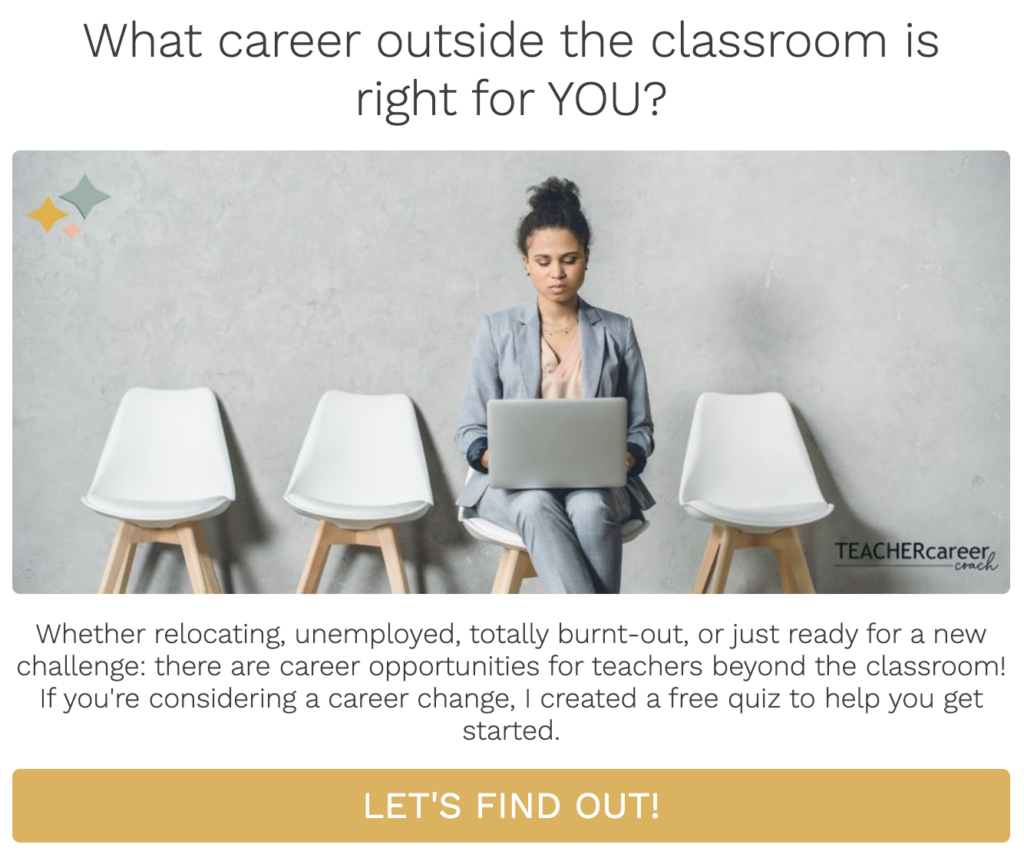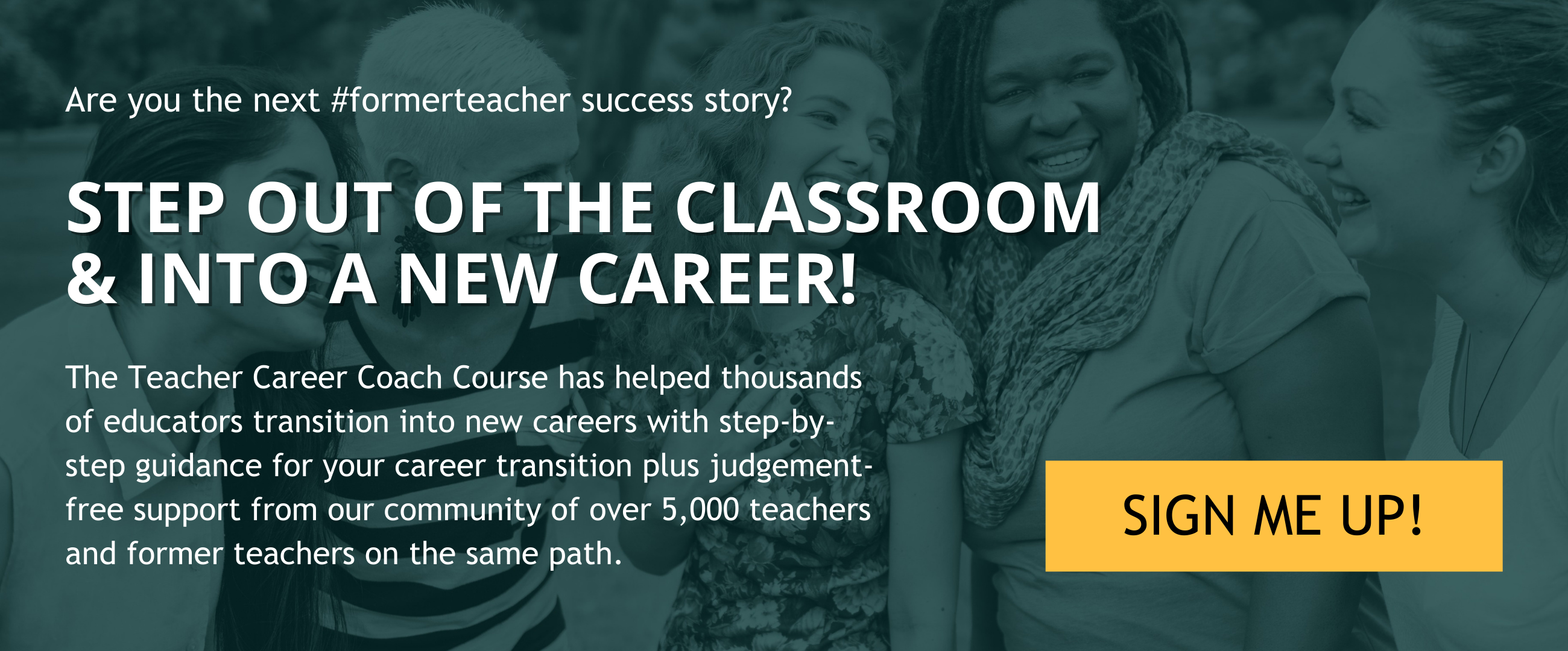If you want to land that new job, you’ll have to work hard on your teacher career change resume. Remember, your teacher transition resume is your first impression. It’s all about showcasing those transferrable skills and highlighting why you’re the best fit for getting the job done.
If you need help leaving the classroom, check out the Teacher Career Coach Course. This step-by-step guide has helped thousands with a transition from teaching. Save time and get support with every step of picking a new path, rewriting your resume, and answering tricky interview questions. You’ll also get access to our judgement-free community of over 5,000 current and former teachers who bounce ideas and seek advice from each other.
It can be intimidating applying to jobs outside of the classroom, no matter how badly you want out! You may be having a hard time identifying the experiences to highlight on your resume. Maybe you’re struggling with how to write them in a way that applies to a job outside of the classroom. Anyhow, you’re about to break through that barrier! Here are some of my top tips from the Teacher Career Coach Course. These will help you put your best foot forward and land that interview! But first, I’m going to let you in on a little secret. You don’t have to start from scratch.
If you’ve ever thought, “I’m just a teacher,” it’s time to look closely at all you do on a daily basis as part of that role. Honestly, teachers are some of the most skillful and multi talented professionals I know. The truth is, many teachers battle with Impostor Syndrome, often overlooking their achievements and the value they bring to the table in many careers. Whether you realize it or not, the skills and accomplishments you have already achieved will make a stellar resume. (Trust me.)
You are an asset to your school, and you’ll be an asset wherever your career transition takes you next. First, identify your career accomplishments as a teacher. Then you can effectively apply them to the next chapter of your working life. Without knowing the specifics of your teaching experience, as a former teacher, I know you have desirable skills and valuable experience. Don’t be afraid to brag about yourself. Your new career change resume should reflect your many achievements and in-demand teacher skills!
Teacher Career Change Resume Resources
In this post, I gathered expert advice to help you master rewriting those resume skills. I want to help you avoid the most common mistakes teachers make when writing their teacher career change resume. Read on to learn how you can tweak your teaching-focused resume to highlight your skills and experience that apply jobs outside of the classroom.
You can also listen to my interview with HR and resume writing expert Alli Arney to learn how to effectively translate your teaching experience on your transition resume.
Let’s get to rebranding your expertise, shall we?
*But first a note!* Much of what you include in your resume and cover letter will be dependent on the job for which you’re applying. If you’re not sure what jobs you’re qualified for or even what’s out there, take a look at Best Jobs For Former Teachers. This post will give you an idea of what’s out there, who’s hiring, and what you need to qualify for a position.
Writing a Cover Letter for Your Resume
Every teacher career change resume needs a cover letter! Your cover letter introduces who you are and what you can offer in position X at company Y. A common mistake I see teachers make is creating a generic cover letter to send with all of their applications.
Some hiring managers may approach your application with the assumption you’re willing to take any job outside of the classroom. Even if that’s the truth, you don’t want the hiring manager to know that. Use the cover letter and an opportunity to showcase why their job is a great fit for you and what you can bring to the table for their company. Hiring managers want someone qualified, excited about the position, and a good fit for the company culture.
Make sure every cover letter is unique to the job and company you are sending it to. Add in specifics regarding what excites you about the role and how your experience will translate into the new responsibilities. Do research about the company and address how you are equally passionate about their core values and company culture. You will learn so much from a company’s website, including its mission statement and core values.
Get Started on Your Cover Letter
First, start with an introduction paragraph. This will likely stay the same on every cover letter as you introduce yourself. Next, add five to six bullet points about why you are qualified for this specific position and reflect on your qualifying achievements. For example, I am constantly focused on collaborative relationships and strategic partnerships that advance the mission, vision, and goals of the organization. Last, add a closing statement about the position to which you’re applying, why it excites you, and how you will be able to effectively fulfill the role and responsibilities.
Add an Elevator Pitch to Your Teacher Career Change Resume
An elevator pitch is basically highlights who you are, your area of expertise, and your career intentions. It’s clear, concise, and is key to a teacher transition resume. Think about it like this: Imagine being on an elevator and only having about 30 seconds to sell yourself to the hiring manager. You should utilize your elevator pitch on your resume and when you get in front of a hiring manager at an interview. Just like your cover letter, this pitch should always be catered to a specific audience rather than being overly generic.
Practice your elevator pitch so that it is second nature. It may sound silly but practicing your pitch in front of a friend or even a mirror helps. You can gain confidence in front of a hiring manager or an interview committee after practicing.
Again, an elevator pitch goes beyond your resume. Have your pitch handy at networking events, in job interviews, on any social bios, and in your resume header. Let’s say you are an experienced teacher looking for a transition into a Training and Development Manager position. Here’s an example of an elevator pitch you could use at a networking event or in your LinkedIn bio:
Elevator Pitch Examples
“I have more than 10 years of experience in training and development as a high school teacher where I have planned, directed, and coordinated various vocational programs. I am skilled in the ADDIE Model and various training methodologies, and I am currently looking to transition from the classroom to the corporate world. If you know anyone who is adding to their Training and Development Team, I hope you’ll send them my way.“
To adjust it to be more resume friendly, you could make the following tweaks:
“I have more than 10 years of experience in training and development as a high school teacher where I have planned, directed, and coordinated various vocational programs. I am skilled in the ADDIE Model and a variety of training methodologies, and I am currently looking to make a transition from the classroom to the corporate world as a Corporate Trainer at Company X.”
While your elevator pitch is short and sweet, you should always be prepared for follow-up questions. Make sure you are comfortable with the different occupational terms and acronyms associated with any career path you seek. This shows your audience that you are knowledgeable and ready to move into that field of work.
Developing Your Teacher Career Change Resume: Formatting Essentials
When it comes to your teacher transition resume, we need to talk about the big F-word: Formatting.
A whopping 75% of resumes NEVER GET OPENED or seen by a hiring manager. One of the biggest culprits? Formatting. Many companies use Applicant Tracking Systems (ATS) to sift through applications before they even make their way to a hiring manager’s hands. Luckily there are a few formatting tips that can help you pass the test.
Length, File Format, and Other Tips for Your Teacher Career Change Resume
When it comes to the length of your resume, it really depends on your experience. While one-page resumes were once a rule-of-thumb, most resumes are now one and a half to two pages. However, if you have 15 years of work experience, you shouldn’t shy away from your accomplishments. In that case, it’s totally acceptable to have a 2-page resume.
Next, you want to focus on another F-word: file format. There are different platforms and software, but I recommend you send your resume as a Word document, unless otherwise specified. So, when you go to save your resume file, be sure it’s saved in the .doc or .docx format. ATS will reject files saved in Pages, Excel, or JPEG format.
The last big resume formatting tip is about style. If your go-to is a creative and colorful template that landed you your job in the classroom, it’s time for a change. Simple, chronological resume templates are your best bet in the corporate world, listing your experience starting with your most recent job. This is the most popular resume style, and it’s best for ATSs. It also happens to be preferred by recruiters and HR professionals, so you really can’t go wrong here.
A chronological resume should be written to include the following elements in the listed order:
- Header (including your personal information and your keyword-rich elevator pitch)
- Experience
- Education
- Technology experience and expertise
- Current volunteer experience (if applicable)
Developing Your Teacher Career Change Resume: Spill About Your Skills (the Right Way).
As a teacher, you already have skills that can be utilized in the corporate world. It’s time to brag about them. Before you can do that, you have to move past any Impostor Syndrome you may be experiencing and acknowledge the value, experience, and expertise you have to offer. Trust me. You have a lot more to offer in roles outside of the classroom than you may think.
For example, your organization and multitasking skills can easily transfer to administrative tasks. Parent-teacher conferences give you the experience to handle customer service situations, conflict resolution, and stakeholder engagement. You’re no stranger to goat setting or data tracking and analysis. Think about any committees or after-school activities you’ve contributed to or helped organize as project management experience.
Related Resources: Creating your Instructional Designer Resume
WALKING THE WALK AND TALKING THE TALK
It’s not just about identifying your transferable skills but how you translate them on your resume.
Here are three of my biggest tips to help you effectively translate your transferable skills and experience on your teacher transition resume.
First, be specific by quantifying your accomplishments.
Second, unless you transition into an education-based role, leave out the teacher-specific terminology, acronyms, or pedagogy. One of the biggest mistakes teachers make on their transition resumes is not rewriting or translating their resume experience so that it is applied to the world outside of the classroom setting.
Make sure you are showcasing your skills and experience in a way that translates into the new roles you are looking for. Hiring managers don’t want to see you as a teacher. They want to see you as someone qualified for and ready to take on the role you are applying for. Depending on the role, managers don’t want to know about record keeping for 25 students, but that you managed a portfolio of 25 clients. They don’t want to hear about teaching pedagogy and lesson planning but about training strategy and training materials. The corporate world isn’t about grading and cumulative assessments but about data tracking and analysis.
Go back to your career buckets. Figure out which teaching duties fall under each and then focus on translating the teacher-specific language into corporate-appropriate terminology. Then you’ll have an already translated list you can easily pull from any time you need to tailor a resume for a new job.
Do Your Research For Your Teacher Career Change Resume
Last but not least, do your research and include job and industry-specific language and keywords in your resume. These terms should be peppered throughout your elevator pitch summary and throughout your highlighted experiences throughout your resume. Not only will using the language make your experience and skills more relatable to the position you are applying for, but it will show the hiring manager that you have done the work and are fully committed to stepping into the role, rather than a teacher looking for any new job they can get.
Insider tip? You can utilize job descriptions as a tool, looking for the keywords and experiences highlighted throughout. Find a way to incorporate the industry-specific language as you translate your skills and experiences. Just make sure you know enough to expand upon the ideas if asked in an interview.
If you don’t feel like you have experience in any of the major keywords that pop up, look them up before you write them off. You likely have more experience than you are giving yourself credit for. More often than not, teachers have the skills. They’re just used to calling it something else.
Acquiring New Skills for Your Teacher Change Resume
Even after translating all of your relevant experience, you might find that there are some areas where you are lacking and that’s okay. Depending on the experiences you had while teaching and the role you are looking to transition into, you might find that there are certain skills that would be beneficial to have to make you a more desirable candidate.
The good news is you can work on new skills while you are still teaching in the classroom. There are a variety of online classes and tutorials you can take at home and add to your teacher transition resume. The added keywords will make it easier for you to find a new career and you’ll likely go into it feeling more confident and prepared.
Developing your Teacher Career Change Resume: Final Thoughts.
I know that was a lot of information. Maybe you were already stressed about writing your career transition resume, and now you’re feeling even more overwhelmed. If that’s the case, start by taking a deep breath. (Right here, right now). You don’t have to write and send out a hundred resumes in one day, or even one week.
In fact, you don’t have to write hundreds of resumes at all.
A lot of teachers ask, “Do I have to create a million different resume templates for all of these jobs?” Absolutely not. While you should tweak your resume to fit each specific position you are applying for, you can save time by creating a template for each general category of positions you apply to. For example, you might have one template for training-type positions and another for jobs that fall under curriculum writing and instructional design categories.
One final word of advice? When it comes to taking resume writing advice, please, please, please vet your source to ensure the information applies to the position and industry you are applying to.
Teacher Career Change, Beyond the Resume
Developing a professional teacher transition resume is just the first step on your journey to a new career. If you have more questions like: How do I get employers to notice my resume? What kind of jobs am I qualified for? What do I do after I get the interview?!?
I want you to know that if being in the classroom is no longer an option for you, there are many career options for teachers. As a former teacher who transitioned out of the classroom, I have been at that crossroads. I successfully moved from teaching into a new career that has left me happier, healthier, and more relaxed than I ever could have been in the classroom.
Next steps to a new career
One of the biggest mistakes that we see teachers make is that they try to navigate this process alone. Often, they put off “researching” until the very last minute. Which sets them up for a very stressful application season. I want to help you get some clarity in the options available to you. To know EXACTLY what you need to do (and not do) in order to get your foot in the door.
You don’t have to do this on your own.
With the help of an HR expert with over 10 years of experience and a team of former teachers, I’ve created a guide to support you in the early stages of your transition out of the classroom. Tap the button below to learn more.


